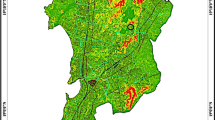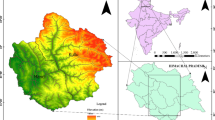Abstract
The Miyun Reservoir is the most important source of drinking water in Beijing, China. Based on the Landsat satellite series image, this paper compared four index methods (NDWI, RNDWI, MNDWI, AWEIsh-superimposed MNDWI) to extract the water body area of Miyun Reservoir from 1979 to 2018 to study its changes in the past 40 years. Furthermore, the internal and external driving forces of reservoir water body area change are studied by correlation analysis and catastrophe analysis. Compared to the characteristic curve of reservoir area calculation, it indicated that the AWEIsh-superimposed MNDWI method has the highest accuracy. The statistical, temporal and spatial analysis showed that the water body area changes of Miyun Reservoir are mainly divided into four distinct stages: (1) It increased in 1979–1997, which was mainly due to the increase in precipitation and the low level of economic development. In 1997, the maximum value (161.14 km2) was reached, which was 108.64 km2 higher than the minimum value. (2) It shrank rapidly in 1997–2004. The areas had dropped by 101.61 km2. By 2004, it was 59.61 km2. The main reason is that the reservoir has suffered from persistent drought for many years after discharging water. (3) It maintained at a lower water level in 2004–2015, with an average annual area of 78 km2. The reason is the low precipitation and rapid economic development. (4) It grew rapidly after 2015, mainly due to water from the South-to-North Water Transfer Project, coupled with the increased precipitation. By 2018, the water body area reached 125.42 km2.









Similar content being viewed by others
References
Cao, R. L., Li, C. J., Liu, L. Y., Wang, J. H., & Yan, G. G. (2008). Extracting Miyun Reservoir’ s water area and monitoring its change based on a revised normalized different water index. Science of Surveying and Mapping,33(02), 158–160. (in Chinese with English abstract).
Dawson, D., Vanlandeghem, M. M., Asquith, W. H., & Patiño, R. (2015). Long-term trends in reservoir water quality and quantity in two major river basins of the southern great plains. Lake and Reservoir Management,31(3), 254–279.
Feyisa, G. L., Meilby, H., Fensholt, R., & Proud, S. R. (2014). Automated water extraction index: A new technique for surface water mapping using Landsat imagery. Remote Sensing of Environment,140(1), 23–35.
Fisher, A., Flood, N., & Danaher, T. (2016). Comparing Landsat water index methods for automated water classification in eastern Australia. Remote Sensing of Environment,175, 167–182.
Gang, D. G., Qi, W. X., Liu, H. J., & Qu, J. H. (2017). Impact of South-to-North Water Diversion Project on phosphorus release from water level fluctuating zone at Miyun Reservoir. Acta Scientiae Circumstantiae,37(10), 3813–3822. (in Chinese with English abstract).
Han, B. P. (2010). Reservoir ecology and limnology in China: A retrospective comment. Journal of Lake Sciences,22(2), 151–160. (in Chinese with English abstract).
Hong, S. H., & Xing, F. R. (2010). Review of Miyun Reservoir construction process: To commemorate the 50th anniversary of Miyun Reservoir. Beijing Water Resources,05, 7–11. (In Chinese).
Ji, H. X., Fan, X. W., Wu, G. P., & Liu, Y. B. (2015). Accuracy comparison and analysis of methods for water area extraction of discrete lakes. Journal of Lake Sciences,27(02), 327–334. (in Chinese with English abstract).
Khaled, H., Hamed, A., & Ramachandra, R. (1998). A modified Mann-Kendall trend test for autocorrelated data. Journal of Hydrology,204(1), 182–196.
Lange, J., Lohr, H., & Polczyk, H. (2010). Integration operation of water quantity and quality at the Olef reservoir. 15th German Dam Symposium,100(4), 47–49.
Li, W. B., Yu, C. Y., Zhang, Q. W., & Cao, B. (2008). Estimation of water area based on normalized water body index. People’s Yangtze River,39(02), 11–12. (in Chinese with English abstract).
Lin, Q. Q., & Han, B. P. (2001). Reservoir limnology and its application in water quality management: An overview. Acta Ecologica Sinica,21(06), 1034–1040. (in Chinese with English abstract).
Mcfeeters, S. K. (1996). The use of the Normalized Difference Water Index (NDWI) in the delineation of open water features. International Journal of Remote Sensing,17(7), 1425–1432.
Mei, Y., Chang, C. C., Dong, Z., & Wei, L. (2016). Stream, lake, and reservoir management. Water Environment Research,88(10), 1533–1563.
Qin, L. H., Zhou, J. X., Li, X. Y., & Zeng, Q. H. (2018). Change trend and period of annual runoff in upstream watershed of Miyun Reservoir. Journal of China Hydrology,38(06), 1941–1951. (in Chinese with English abstract).
Rokni, K., Ahmad, A., Selamat, A., & Hazini, S. (2014). Water feature extraction and change detection using multitemporal landsat imagery. Remote Sensing,6(5), 4173–4189.
Rover, J., Ji, L., Wylie, B. K., & Tieszen, L. L. (2012). Establishing water body areal extent trends in interior Alaska from multi-temporal landsat data. Remote Sensing Letters,3(7), 595–604.
Tong, L. X., Yan, Q., Luo, C. F., & Du, Y. K. (2017). Water body information extraction based on NDWI segmentation and object-oriented method. Geospatial Information,15(05), 57–59. (in Chinese with English abstract).
Tri, A., Anoj, S., & Dong, L. (2018). Evaluation of water indices for surface water extraction in a Landsat 8 scene of Nepal. Sensors,18(8), 2580–2594.
Unni, N. V. M. (1983). Forest survey and management using remote sensing. Proceedings of the Indian Academy of Sciences Section C: Engineering Sciences,6(3), 209–232.
Wanga, X., Xiea, S., Zhanga, X., Chend, C., & Guoe, H. (2018). A robust multi-band water index (MBWI) for automated extraction of surface water from Landsat 8 OLI imagery. International Journal of Applied Earth Observation and Geoinformation,68, 73–91.
Xia, J., Li, L., Yan, M. C., & Zhu, J. (2008). Impacts of climate change on water resource of Miyun Reservoir and adaptation managements. Advances in Climate Change Research,4(06), 319–323. (in Chinese with English abstract).
Xie, H., Luo, X., Xu, X., Pan, H., & Tong, X. (2016). Evaluation of landsat 8 OLI imagery for unsupervised inland water extraction. International Journal of Remote Sensing,37(8), 1826–1844.
Xiong, L. H., Deng, R. R., Li, J., Liu, X. L., Qin, Y., Liang, Y. H., et al. (2018). Subpixel surface water extraction (SSWE) using Landsat 8 OLI data. Water,10(5), 653–667.
Xu, H. Q. (2005). A Study on information extraction of water body with the modified normalized difference water index. Journal of Remote Sensing,9(05), 589–595. (in Chinese with English abstract).
Xu, J. H. (2006). Quantitative geography. Beijing: Higher Education Press. (in Chinese).
Yang, J. W., Liu, C. Y., Shu, R., & Xie, F. (2018). The extraction of urban surface water from hyperspectral data based on spectral indices. Journal of the Indian Society of Remote Sensing,46(11), 1749–1759.
Zhai, K., Wu, X., Qin, Y., & Du, P. (2015). Comparison of surface water extraction performances of different classic water indices using OLI and tm imageries in different situations. Geo-spatial Information Science,18(1), 32–42.
Zhang, Y. F., Ai, H. B., Du, Q. Y., & Zhang, L. (2014). Application of water extraction algorithm based on pyramid image segmentation in automatic aerial triangulation for island and reef. Bulletin of Surveying and Mapping,12, 70–73. (in Chinese with English abstract).
Zhang, B. L., Jia, R. C., Zhang, Q., & Cheng, G. (2011). The water body area changes of Dalainur Lake based on satellite images of remote sensing. Research of Soil and Water Conservation,18(06), 196–199. (in Chinese with English abstract).
Zhang, J., Lei, X., Chen, B., & Song, Y. (2019). Analysis of blue water footprint of hydropower considering allocation coefficients for multipurpose reservoirs. Energy. https://doi.org/10.1016/j.energy.2019.116086.
Zheng, Z. F., Ren, G. Y., Wang, Y. T., & Dou, J. X. (2017). Observational study on climate effect of large artificial lake: Taking Miyun Reservoir as an example. Scientia Geographical Sinica,37(12), 1933–1941. (in Chinese with English abstract).
Zhong, Y. H., Lu, F., Yi, Z., & Zhao, J. (2013). Change trend and period of annual runoff in upstream watershed of Miyun Reservoir. Journal of China Hydrology,33(06), 81–84. (in Chinese with English abstract).
Acknowledgements
This work was supported by National Key R&D Program of China (2017YFC0406004) and National Natural Science Foundation of China (41271004).
Author information
Authors and Affiliations
Corresponding author
Additional information
Publisher's Note
Springer Nature remains neutral with regard to jurisdictional claims in published maps and institutional affiliations.
About this article
Cite this article
Lai, Y., Zhang, J., Song, Y. et al. Comparative Analysis of Different Methods for Extracting Water Body Area of Miyun Reservoir and Driving Forces for Nearly 40 Years. J Indian Soc Remote Sens 48, 451–463 (2020). https://doi.org/10.1007/s12524-019-01076-5
Received:
Accepted:
Published:
Issue Date:
DOI: https://doi.org/10.1007/s12524-019-01076-5




